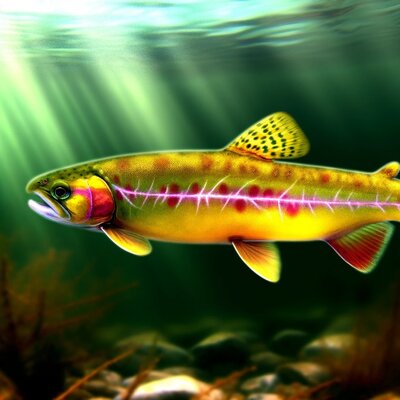Lightning trout, a striking variant of the rainbow trout, captivate anglers and nature enthusiasts alike with their unique coloration and elusive nature. Unlike their more common counterparts, lightning trout boast a golden hue, punctuated by a pink lateral line that seems to glow, giving rise to their electrifying name. This essay delves into the fascinating world of lightning trout, exploring their characteristics, habitat, genetic background, and significance within their ecosystems and to human interests.

Physical Characteristics and Habitat
Lightning trout are distinguished by their vibrant, golden-yellow bodies and a conspicuous pink or red stripe running along their sides. This vivid coloration not only makes them a prized catch among anglers but also a subject of interest for biologists studying trout species' diversity. Typically found in freshwater environments, lightning trout favor cold, clear waters with abundant aquatic vegetation, which provides cover and feeding opportunities. Their habitats range from mountain streams to alpine lakes, where specific conditions support their growth and reproductive needs.
Genetic Background and Breeding
The distinct appearance of lightning trout is the result of selective breeding, primarily aimed at enhancing their unique coloration and size for sport fishing. They share a genetic lineage with the rainbow trout, Oncorhynchus mykiss, but have been isolated and bred to accentuate their remarkable traits. This selective breeding process does not involve genetic modification but rather a careful selection of breeding stock to produce offspring with desired characteristics. Hatcheries play a crucial role in the propagation of lightning trout, ensuring a sustainable population for stocking in lakes and rivers, thereby supporting recreational fishing without negatively impacting native trout populations.
Ecological Significance
Despite being a product of selective breeding, lightning trout adapt well to their naturalized environments, where they participate actively in local food webs. Their diet primarily consists of insects, small fish, and crustaceans, making them an integral part of the aquatic ecosystem. As predators, they help maintain the balance by controlling the populations of their prey species. However, their introduction into non-native habitats must be managed carefully to avoid disrupting existing ecological balances.
Conservation Status and Challenges
While lightning trout are not considered a natural species and thus do not have a specific conservation status, their existence raises important discussions about conservation and biodiversity. The primary challenges facing lightning trout involve habitat degradation and the impacts of climate change on freshwater ecosystems. Conservation efforts focus on maintaining healthy aquatic habitats and ensuring that stocking practices do not harm native species or ecosystems. Engaging anglers in conservation practices is also crucial, promoting catch-and-release fishing and awareness about the ecological roles of stocked species like lightning trout.
Recreational Fishing and Economic Impact
For the angling community, lightning trout offer an exciting and slightly elusive target, known for their fighting spirit and the aesthetic appeal of their catch. Special regulations may govern their fishing to ensure sustainability, including catch limits and designated seasons, enhancing the fishing experience while promoting conservation. The stocking of lightning trout in recreational fisheries has a significant economic impact, drawing anglers to local communities, boosting tourism, and generating funds for conservation programs. This mutually beneficial relationship underscores the importance of responsible management practices that support both recreational fishing and ecosystem health.
Conclusion
Lightning trout, with their luminous presence and genetic uniqueness, are more than just a prized catch for anglers; they symbolize the intricate balance between conservation, recreational fishing, and the maintenance of biodiversity. Their introduction into freshwater habitats must be navigated with care, ensuring that these beautiful creatures continue to thrive without compromising the ecological integrity of their environments. As we marvel at the beauty and resilience of lightning trout, we are reminded of our responsibility to protect and preserve the natural world, ensuring that future generations can enjoy the splendor and diversity of life on our planet.

